12/28/2011. Another round of adjustments to the guiding setup. The apparatus supporting the guidescope, which I haven't used since getting the OAG working well, seemed awkward. It interfered with the cover; it weighed too much; and it still permitted some flex. So I rethought the problem and then cut some brass and aluminum. First, there's always a useful guide star at that short focal length, so if I can get the ST80 aligned with the main 'scope, there's really no need to adjust it again. Removing adjustability makes bracketry much simpler and lighter. I settled on supporting the guide scope between two brass bars bolted to a thick aluminum plate on a single Losmandy D-clamp. I enlarged one of the holes originally used to hold a 1/4x20 tripod socket on the bottom of the Short Tube 80 and dropped a cap-head 10x24 bolt through it into a blind threaded hole in the aluminum plate (you can just see the bolt between the two brass rails in the first photo below -- I don't know why the nearer one looks squarshed; they're both round as could be).
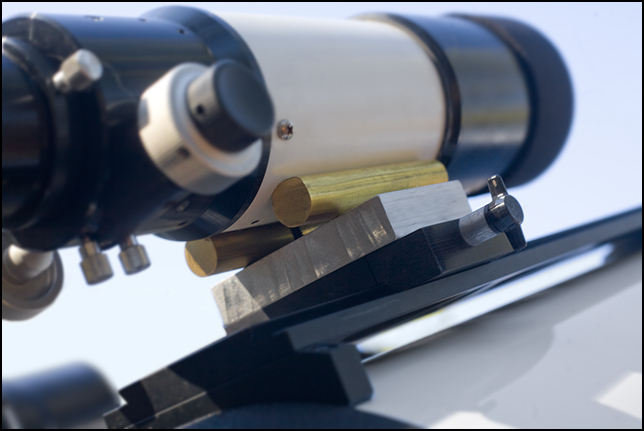
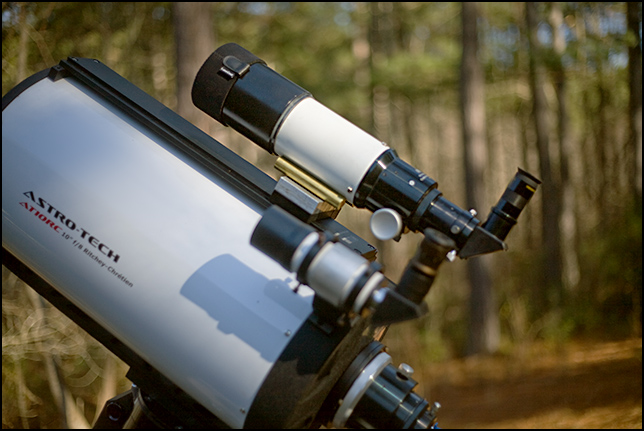
I think that's borderline elegant. Tonight I'll confirm that it is aligned reasonably well. Sooner or later, I'll put a guide camera behind it and see if it stays pointed. If so, then we can do telecompressed and DSLR imaging with the Ritchey. If it doesn't, I can still add back a ring or two for support. Later that same night: yeppers! It's aligned within half a degree! I mean, I took some care in the shop, but that's better than I had any reason to expect. If finer aim is needed, an Orion X-Y adjuster can be fitted. It's plenty close enough to continue working as a big finder / orientation scope (as it has been lately) when not employed as a guidescope. And I'm thinking that 9x60 finder can probably be put away until and unless needed; taken all together this means it's time to adjust the counterweights.
The early evening was too cloudy for trials. It was too cloudy to find a guide-star in the OAG, too. So I did this unguided image of the center of M31, through haze and some substantial clouds just to be doing something while waiting for clearer skies to work in from the west:
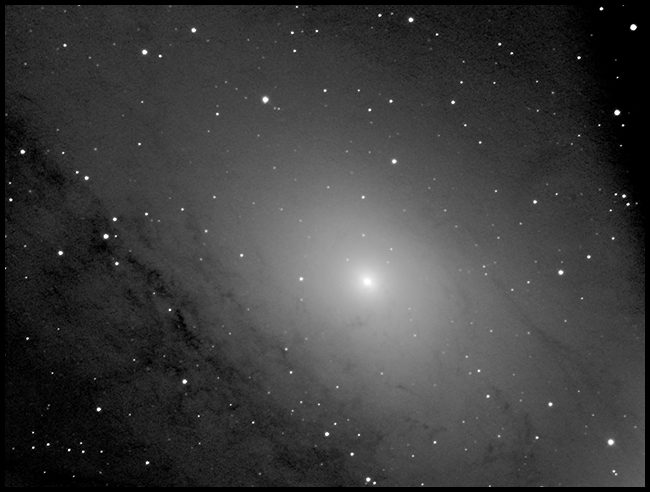
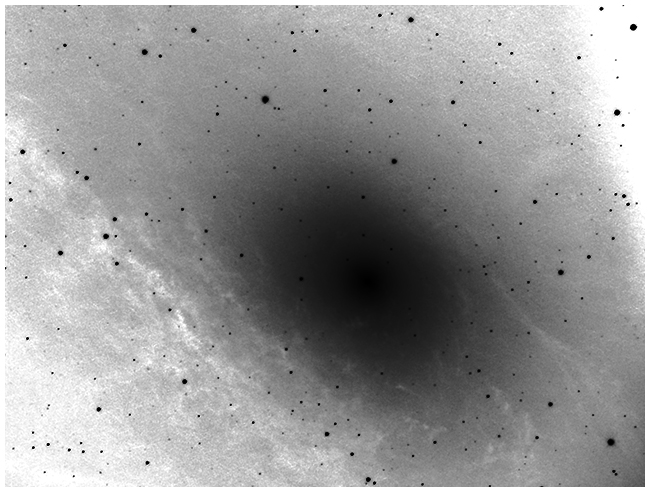
Dust clouds in the center of M31
90x60s, -30C
The ClearSkyClock for Colby, NC, was dead on yet again: a period of cloudiness early followed by clearing. The sky cleared as forecast about 9:00.
I slewed to IC 342, a large, nearby galaxy almost hidden by the stars of the giraffe. It's a real forest-for-the-trees sort of galaxy. In the first treatment, you see it as it looked while I framed it up. Nothing special: the view is dominated by foreground stars of the Milky Way. Then appropriately stretched to reveal the galaxy hidden among the stars. And third, a color rendition.
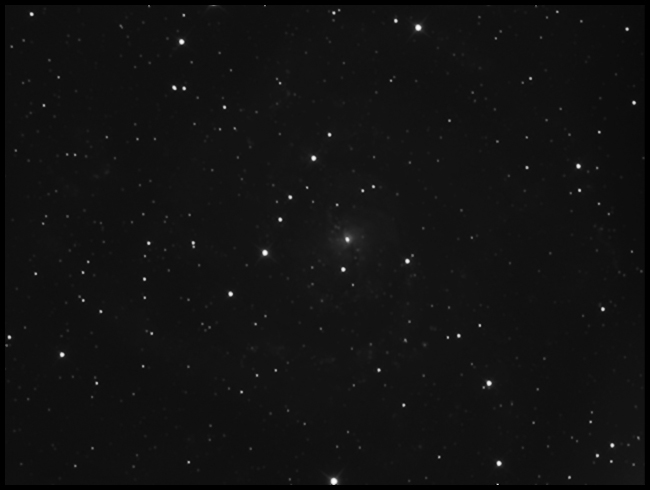

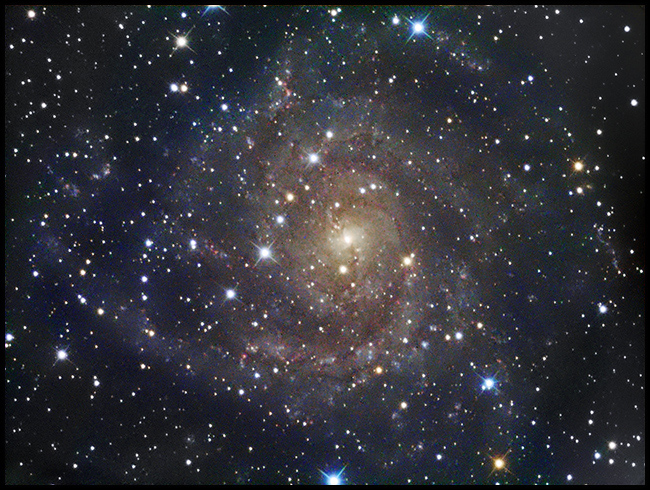
IC342 a galaxy in Camelopardalis
4x900s L first two images
4x900s, 1x900s RGB third image
I'm gathering hydrogen-alpha images while I prep this page. The first 1800s integration doesn't show as much action in the spiral arms as I expected. On second look (which seems to be the theme of this particular part of the sky), there are tons of small active regions lining the arms, but they're way, way down in the "shadows." If the sky holds up, I'll have enough signal to show off tomorrow. If the sky really holds up, I'll try something else after this subject slips down toward the trees.

Same except that the red channel has been replaced by the
sum of the Rx900s image and 3x1800s H-a
This is not the subject I wanted to finish the night with (the pines had other ideas), but it's something neat enough and inviting and I might as well take a first cut at it. Slew to NGC 2237 and then go just a little east to this small part of the Rosette:

NGC 2377
4x1800s H-a, 1x900s L
Except where noted, deep-sky photos are made with an SBIG ST2000XM CCD behind a 10-inch Astro-Tech Ritchey-Chretien carried on an Astro-Physics Mach1GTO. The CCD is equipped with Baader LRGB and 7nm H-a filters. A Meade DSI Pro monochrome camera looking through a modified Orion off-axis guider keeps the OTA pointed in the right direction. The imaging camera is controlled via Nebulosity 2; the guide camera is operated by PHD Guide 1.13, both by Stark Labs. The stock focuser on the AT10RC has been augmented with Robofocus 3.0.9 using adapters turned on the lathe downstairs. Maxim DL5.12 performs image calibration, alignment, and stacking; Photoshop CS4 and FocusMagic 3.0.2 take it from there. Gradient Xterminator by Russell Croman and Astronomy Tools by Noel Carboni see their share of work, too.
:: top ::